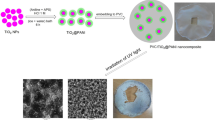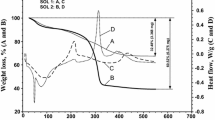Abstract
Photocatalysts supported on polymers are not frequently used in heterogeneous photocatalysis because of problems such as wettability and stability that affect photocatalysis conditions. In this work, we used polypropylene as support for TiO2 sol-gel to evaluate its stability and efficiency under UV radiation. We also tested the effect of the thermo-pressing PP/TiO2 system on the photocatalytic efficiency and stability under UV radiation. The films were characterized by scanning electron microscopy (SEM), UV-Vis spectroscopy and X-ray diffraction (XRD). The SEM micrographs showed that the films of TiO2 sol-gel onto PP has approximately 1.0-μm thick and regular surface and the generation of polypropylene nanowires on hot-pressed samples. XRD showed the formation of TiO2 anatase on the surface of the films made by dip-coating. All photocatalysts were tested in decontaminating air-containing gaseous formaldehyde (70 ppmv) presenting degradation of the target compound to the limit of detection. The photocatalysts showed no deactivation during the entire period tested (30 h), and its reuse after washing showed better photocatalytic performance than on first use. The photocatalyst showed the best results were tested for 360 h with no observed deactivation. Aging studies showed that the film of TiO2 causes different effects on the photostability of composites, with stabilizing effect when exposed to most energetic UVC radiation (λmax = 254 nm) and degradative effects when exposed to UVA radiation (λmax = 365 nm).












Similar content being viewed by others
References
Allen NS, Edge M (1992) Fundamentals of polymer degradation and stabilization. Elsevier Applied Science, New York
Agnelli JAM, Chinelatto MA (1992) Degradação de polipropileno: aspectos teóricos e recentes avanços em sua estabilização. Polímeros 2:27–31
Bennani J, Dillert R, Gesing TM, Bahnemann D (2009) Physical properties, stability, and photocatalytic activity of transparent TiO2/SiO2 films. Sep Purif Technol 67:173–179. doi:10.1016/j.seppur.2009.03.019
Carlsson DJ, Wiles DM (1969) Photodegradation of polypropylene films. 3: photolysis of polypropylene hydroperoxides. Macromolecules 2:597–606
Chen F, Yang X, Wu Q (2009) Photocatalytic oxidation of Escherichia coli, Aspergillus niger, and formaldehyde under different ultraviolet irradiation conditions. Environ Sci Technol 43:4606–4611. doi:10.1021/es900505h
Chiu C-W, Lin C-A, Hong P-D (2001) Melt-spinning and thermal stability behavior of TiO2 nanoparticle/polypropylene nanocomposite fibers. J Polym Res 18:367–372. doi:10.1007/s10965-010-9426-0
De Paoli MA (2009) Degradação e Estabilização de Polímeros. Artliber, São Paulo
El-Dessouky MH, Lawrence CA (2011) Nanoparticles dispersion in processing functionalised PP/TiO2 nanocomposites: distribution and properties. J Nanoparticle Res 13:1115–1124. doi:10.1007/s11051-010-0100-6
Fechine GJM, Fernandes LL, Freitas CA, Demarquette NR (2012) Estudo do Efeito do Tipo de Polipropileno na Fotodegradação da Blenda Polipropileno/Poliestireno de Alto Impacto. Polímeros 22:61–68. doi:10.1590/S0104-14282012005000013
Hamid SH (2000) Handbook of polymer degradation. CRC, New York
Hewer TLR, Suarez S, Coronado JM, Portela R, Avila P, Sanchez B (2009) Hybrid photocatalysts for the degradation of trichloroethylene in air. Catal Today 143:302–308. doi:10.1016/j.cattod.2009.02.001
Hurum DC, Gray KA, Rajh T, Thurnauer MC (2004) Photoinitiated reactions of 2,4,6 TCP on Degussa P25 formulation TiO2: wavelength-sensitive decomposition. J Phys Chem B 108:16483–16487. doi:10.1021/jp047097m
Jeong J, Sekiguchi K, Sakamoto K (2004) Photochemical and photocatalytic degradation of gaseous toluene using short-wavelength UV irradiation with TiO2 catalyst: comparison of three UV sources. Chemosphere 57:663–671. doi:10.1016/j.chemosphere.2004.05.037
Kasanen J, Suvanto M, Pakkanen TT (2009) Self-cleaning, titanium dioxide based, multilayer coating fabricated on polymer and glass surfaces. J Appl Polym Sci 111:2597–2606. doi:10.1002/app.29295
Kim D-J, Pham H-C, Park D-W, Kim K-S (2011) Preparation of TiO2 thin films on polypropylene beads by a rotating PCVD process and its application to organic pollutant removal. Chem Eng J 167:308–313. doi:10.1016/j.cej.2010.12.069
Klepeis NE, Nelson WC, Ott WR, Robinson JP, Tsang AM, Switzer P, Behar JV, Hern SC (2001) The national human activity pattern survey (NHAPS): a resource for assessing exposure to environmental pollutants. J Expo Anal Environ Epidemiol 11:231–252. doi:10.1038/sj.jea.7500165
Kwon H-J, Lee Y-W, Kim H-S, Zhoh C-K, Park K-W (2013) One-dimensional TiO2 nanostructures with improved UV-blocking properties. Mater Lett 93:175–178. doi:10.1016/j.matlet.2012.11.130
Lee CM, Kim YS, Nagjyoti PC, Park W, Kim KY (2011) Atmospheric concentration of ammonia, nitrogen dioxide, nitric acid, and sulfur dioxide by passive method within Osaka prefecture and their emission inventory. Water Air Soil Pollut 215:229–237. doi:10.1007/s11270-010-0472-3
Matsuzawa S, Maneerat C, Hayata Y, Hirakawa T, Negishi T, Sano T (2008) Immobilization of TiO2 nanoparticles on polymeric substrates by using electrostatic interaction in the aqueous phase. Appl Catal B Environ 83:39–45. doi:10.1016/j.apcatb.2008.01.036
Obee T, Brown RT (1995) TiO2 photocatalysis for indoor air applications: effects of humidity and trace contaminant levels on the oxidation rates of formaldehyde, toluene, and 1–3 butadiene. Environ Sci Technol 29:1223–1231. doi:10.1021/es00005a013
Ohtani B, Adzuma S, Miyadzu H, Nishimoto S, Kagiya T (1989) Photocatalytic degradation of polypropylene film by dispersed titanium dioxide particles. Polym Degrad Stab 23:271–278
Paz Y (2010) Application of TiO2 photocatalysis for air treatment: patents’ overview. Appl Catal B Environ 99:448–460. doi:10.1016/j.apcatb.2010.05.011
Portela R, Sánchez B, Coronado JM, Candal R, Suárez S (2007) Selection of TiO2-support: UV-transparent alternatives and long-term use limitations for H2S removal. Catal Today 129:223–230. doi:10.1016/j.cattod.2007.08.005
Puma GL, Puddu V, Tsang HK, Gora A, Toepfer B (2010) Photocatalytic oxidation of multicomponent mixtures of estrogens (estrone (E1), 17β-estradiol (E2), 17α-ethynylestradiol (EE2) and estriol (E3)) under UVA and UVC radiation: photon absorption, quantum yields and rate constants independent of photon absorption. Appl Catal B Environ 99:388–397. doi:10.1016/j.apcatb.2010.05.015
Rabello MS, White JR (1997a) Crystallization and melting behaviour of photodegraded polypropylene-1. Chemi-crystallization. Polymer 38:6379–6387. doi:10.1016/S0032-3861(97)00213-9
Rabello MS, White JR (1997b) The role of physical structure and morphology in the photodegradation behaviour of polypropylene. Polym Degrad Stab 56:55–73. doi:10.1016/S0141-3910(96)00202-9
Sánchez B, Coronado JM, Candal R, Portela R, Tejedor I, Anderson MA, Tompkins D, Lee T (2006) Preparation of TiO2 coatings on PET monoliths for the photocatalytic elimination of trichloroethylene in the gas phase. Appl Catal B Environ 66:295–301. doi:10.1016/j.apcatb.2006.03.021
Sarigiannis DA, Karakitsios SP, Gotti A, Liakos IL, Katsoyiannis A (2011) Exposure to major volatile organic compounds and carbonyls in European indoor environments and associated health risk. Environ Int 37:74–765. doi:10.1016/j.envint.2011.01.005
Shan AY, Ghazi TIM, Rashid SA (2010) Immobilisation of titanium dioxide onto supporting materials in heterogeneous photocatalysis: a review. Appl Catal A Gen 389:1–8. doi:10.1016/j.apcata.2010.08.053
Shie J-L, Lee C-H, Chiou C-S, Chang T-C, Chang CC, Chang CY (2008) Photodegradation kinetics of formaldehyde using light sources of UVA, UVC and UVLED in the presence of composed silver titanium oxide photocatalyst. J Hazard Mater 155:164–172. doi:10.1016/j.jhazmat.2007.11.043
Shiraishi F, Ikeda S, Kamikariya N (2009) Photocatalytic decompositions of gaseous HCHO over thin films of anatase titanium oxide converted from amorphous in a heated air and in an aqueous solution of hydrogen peroxide. Chem Eng J 148:234–241. doi:10.1016/j.cej.2008.08.021
Siqueira CYS, Gioda A, Carneiro FP, Ramos MCKV, Aquino Neto FR (2011) Distribution of indoor air pollutants in downtown Rio de Janeiro, Brazil. J Braz Chem Soc 22:2127–2138. doi:10.1590/S0103-50532011001100015
Suciu RC, Indrea E, Silipas TD, Dreve S, Rosu MC, Popescu V, Popescu G, Nascu HI (2009) TiO2 thin films prepared by sol–gel method. J Phys Conf Ser 182:012080. doi:10.1088/1742-6596/182/1/012080
Tavares CJ, Marques SM, Lanceros-Méndez S, Sencadas V, Teixeira V, Carneiro JO, Martins AJ, Fernandes AJ (2008) Strain analysis of photocatalytic TiO2 thin films on polymer substrates. Thin Solid Films 516:1434–1438. doi:10.1016/j.tsf.2007.03.134
Tseng TK, Lin YS, Chen YJ, Chu H (2010) A review of photocatalysts prepared by sol–gel method for VOCs removal. Int J Mol Sci 11:2336–2361. doi:10.3390/ijms11062336
Waldman WR, De Paoli MA (2008) Photodegradation of polypropylene/polystyrene blends: styrene butadiene styrene compatibilisation effect. Polym Degrad Stab 93:273–280. doi:10.1016/j.Polymdegradstab.2007.09.003
Xu Q, Anderson MA (1994) Sol–gel route to synthesis of microporous ceramic membranes: preparation and characterization of microporous TiO2 and ZnO2 xerogels. J Am Ceram Soc 77:1939–1945. doi:10.1111/j.1151-2916.1994.tb07074.x
Yu H, Zhang K, Rossi C (2007) Experimental study of the photocatalytic degradation of formaldehyde in indoor air using a nano-particulate titanium dioxide photocatalyst. Indoor Built Environ 16:529–537. doi:10.1177/1420326X07083513
Acknowledgments
The authors would like to acknowledge CNPq and FAPERJ for the financial support and Prof. Ricardo Papaleo for the help on the discussion.
Author information
Authors and Affiliations
Corresponding author
Additional information
Responsible editor: Philippe Garrigues
Rights and permissions
About this article
Cite this article
Curcio, M.S., Oliveira, M.P., Waldman, W.R. et al. TiO2 sol-gel for formaldehyde photodegradation using polymeric support: photocatalysis efficiency versus material stability. Environ Sci Pollut Res 22, 800–809 (2015). https://doi.org/10.1007/s11356-014-2683-4
Received:
Accepted:
Published:
Issue Date:
DOI: https://doi.org/10.1007/s11356-014-2683-4




